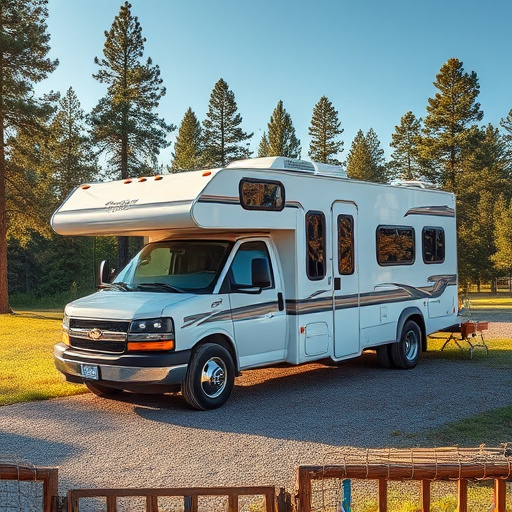Maximizing RV battery performance and longevity requires understanding your specific deep-cycle battery type (lead-acid, lithium, or AGM), regular maintenance (terminal inspection, voltage monitoring, preventing deep discharge), smart charging for extended storage, and proactive issue prevention (annual checks, terminal cleaning, charge level regulation). These steps ensure reliable power for your RV during travel.
Looking to maximize your RV’s on-the-go power? Understanding and maintaining your RV battery system is crucial. This comprehensive guide breaks down 10 essential steps, from grasping the fundamentals of your RV’s electrical architecture to optimizing charging cycles and preventing common issues. By implementing these best practices, you’ll extend the life of your RV battery, ensuring reliable access to electricity whenever adventure calls.
- Understanding Your RV Battery System
- Regular Maintenance for Longevity
- Optimizing Charging Cycles
- Preventing and Addressing Issues
Understanding Your RV Battery System

Understanding your RV battery system is a crucial first step in enhancing its performance and longevity. Recreational vehicles (RVs) are equipped with various electrical systems that rely on powerful, deep-cycle batteries to operate. These batteries differ from automotive batteries in their design, intended use, and capacity. RV batteries are designed to provide consistent power over extended periods, often facing extreme temperature fluctuations and being discharged deeply multiple times a day.
Knowing your specific battery type—whether it’s lead-acid, lithium, or AGM—is essential. Each has unique characteristics, maintenance requirements, and benefits. Lead-acid batteries are common but require more upkeep, while lithium batteries offer longer lifespans and faster charging times. AGM batteries fall in between, known for their reliability and resistance to overcharging. Understanding these variations allows you to tailor your battery care routine accordingly, ensuring optimal RV battery health.
Regular Maintenance for Longevity

Regular maintenance is key to prolonging the life of your RV battery system. By implementing a few simple steps, you can ensure optimal performance and extend the lifespan of your batteries. Start by regularly checking for any signs of damage or corrosion on terminals and connections. Clean these thoroughly to maintain a good electrical connection. Keep an eye on voltage levels during use; consistent overcharging or undercharging can lead to degradation.
Additionally, it’s essential to keep your RV battery system charged when not in use. Deep discharge cycles can significantly reduce battery life. Utilize smart chargers and power management systems to maintain a healthy charge, especially if you store your RV for extended periods. Regular maintenance not only improves battery longevity but also enhances overall performance, ensuring your RV remains reliable on the road.
Optimizing Charging Cycles

Optimizing RV battery charging cycles is a key step in maintaining your vehicle’s power system and prolonging the lifespan of your batteries. By understanding and managing your charging process, you can ensure your RV battery remains in top condition. One effective strategy is to avoid overcharging, as it can lead to damage and reduced performance. Most modern RVs come with advanced charging systems that automatically detect when a battery is fully charged, but it’s still beneficial for owners to be aware of this process.
Regularly monitoring your RV battery during charging allows you to identify any potential issues early on. Aim to charge your batteries at a moderate pace, especially if you’re using solar or generator power. This gentle approach prevents excessive strain on the system and helps maintain optimal battery health. Remember, in the world of RV maintenance, knowing when to stop charging is just as important as starting the process.
Preventing and Addressing Issues

Regular maintenance is key to preventing and addressing RV battery issues. Start by inspecting your batteries for any signs of corrosion, leaks, or damage at least twice a year. Clean corroded terminals with a mixture of baking soda and water to ensure optimal electrical connection. Additionally, check the battery’s state of charge regularly; deep discharge cycles can significantly reduce their lifespan. Aim to keep them charged between 12.6 and 12.8 volts for lead-acid batteries or within the recommended range for lithium models.
Implementing preventive measures will not only prolong your RV battery’s life but also ensure reliable power during your travels. Consider using a smart battery charger to maintain an ideal charge level, avoid overcharging, and extend the overall health of your batteries. Regular maintenance and prompt addressing of any issues will keep your RV battery system running smoothly for years to come.
By understanding your RV battery system, performing regular maintenance, optimizing charging cycles, and proactively preventing issues, you can significantly enhance the longevity and performance of your RV battery. These simple steps will ensure a reliable power source for all your adventures, allowing you to enjoy uninterrupted time on the road. Remember, proper care of your rv battery is key to avoiding costly replacements and keeping your travels smooth and stress-free.
